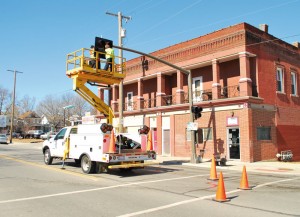By LESLIE COLLINS
Northeast News
March 13, 2013

Kansas City officials are continuing to fine-tune the process for removing unwarranted traffic signals throughout the city.
Last October, the city’s Public Works Department deactivated traffic signals at 39 intersections across the city, changing the signals to flash red or yellow, and installing stop signs. The city failed to inform area residents of the plan and the abrupt change led to confusion and outrage from the community.
Now, the city is hosting a series of public meetings to discuss each intersection and will take a new approach to informing the public on upcoming traffic signal removals.
“We are trying to get a feel from people who have a stake in their neighborhoods on how to move forward and how to make this process work more effectively,” Public Works Spokesperson Sean Demory said during the city’s Feb. 28 Transportation and Infrastructure Committee meeting.
Kansas City has 648 traffic signals and Public Works has evaluated 245 signals. Of the 245 signals, 144 are unwarranted, Demory said. Those signals will eventually be removed. Public Works plans to finish evaluating the remaining 350 traffic signals within the next 18 months.
“We look at this as a safety issue first and foremost,” Demory said.
When unwarranted signals remain in place, they can create excess vehicle delay, cause drivers to take side roads instead, cause additional traffic accidents and encourage drivers to ignore the signal and the rules of the road, he said. Studies indicate a 24 percent to 65 percent increase in accidents at intersections with unwarranted signals, he said.
“This is a process, so it’s (traffic signal removal) something that we are entering into with the community rather than simply imposing. Ultimately, it’s something that will help the community,” Demory said.
Public Works officials are actively working with neighborhood leaders to set up convenient meeting dates to allow the community to discuss nearby affected intersections, Demory said.
During the meetings, Public Works officials will provide an overview of the intersection, explain why the traffic signal is unwarranted and discuss the next action steps. A city traffic engineer will answer the public’s questions and city officials will take notes regarding community concerns and feedback.
“We’ve heard comments at the previous meetings about the volume of pedestrians and the difficulties. They’re finding the residents are choosing to drive somewhere else or they’re not stopping fully,” said Sherri McIntyre, director of the Public Works Department. “It’s mostly a listening session by staff so we can understand what the major concerns are.”
Public feedback will help the Public Works Department to identify solutions to community concerns, Demory said. In the instance of the intersection of St. John and Quincy, which is across from Budd Park and near Holy Cross Catholic School, the solution entailed installing a pedestrian signal, Demory said. Additional striping will be added once weather permits, McIntyre said. Other options for intersections include warning signs and flashers, school speed zones, a grade-separated crossing, among others.
For future unwarranted signals slated for removal, the city will notify the public in advance through a direct mailing and will meet with neighborhood groups. In addition, advance signage will be installed at the affected intersections, notifying drivers of the impending removal, and the signals will flash for six weeks, giving residents time to adjust. Once the Public Works Department has met with community members and adjusted the plans accordingly, the signals will be removed.
“I’m just a little concerned with the procedure. I think the procedure ought to be amended,” City Council member Dick Davis said. “The procedure is blatantly unfair to Sherri (McIntyre). She’s ultimately the decision maker. It’s not that I don’t trust your ability to make a decision, I just think it’s blatantly unfair to you. It’s a decision where you can’t win.”
Davis added that McIntyre shouldn’t have the final say on the traffic signal removal. Elected officials, i.e. the city council, should make the final decision, not the Public Works Department, he said.
McIntyre said there’s a reason for adhering to the guidelines and regulations outlined in the Manual on Uniform Traffic Control Devices (MUTCD).
“There’s a common application on how the rules of the road are applied nationwide, so what Kansas City is doing is not drastically different than what you’re going to find in Overland Park or Minneapolis or wherever you are in the country.”
It’s why stop signs are in the shape of an octagon and why signage standards and lighting standards are consistent nationwide, she said. Consistency is helpful to the driver, she said.
“Our recommendations are these (intersections) do not need traffic signals based on the guidelines and perimeters (in the MUTCD),” McIntyre said. “It’s darn clear you don’t put one in if you don’t meet these requirements, unless there’s political override.”
City Council member Russ Johnson said he’d like the city auditor to research how other U.S. cities handle unwarranted traffic signals and requested the Public Works Department provide accident data to compare whether or not there were less accidents before or after the signal deactivation/removal.
In response to Davis’ suggestion, Johnson cautioned the council about micromanaging the Public Works Department. City Council members aren’t the experts, he said.
“The people in the community elected us to serve their interests,” City Council member Jermaine Reed said. “At the end of the day, that’s what we’re here for. If it’s a simple issue, such as their stop sign, it is important their concerns can be heard and we’re able to help facilitate that interaction in our decision making process. Are we there yet? No, I don’t think we are there yet. Are we going through the proper channels to get us there? I think the answer is yes.”

















